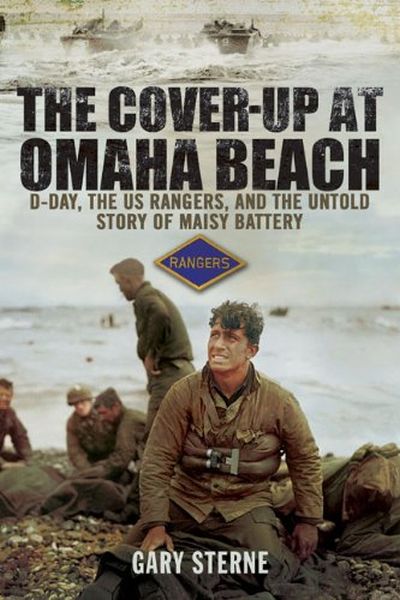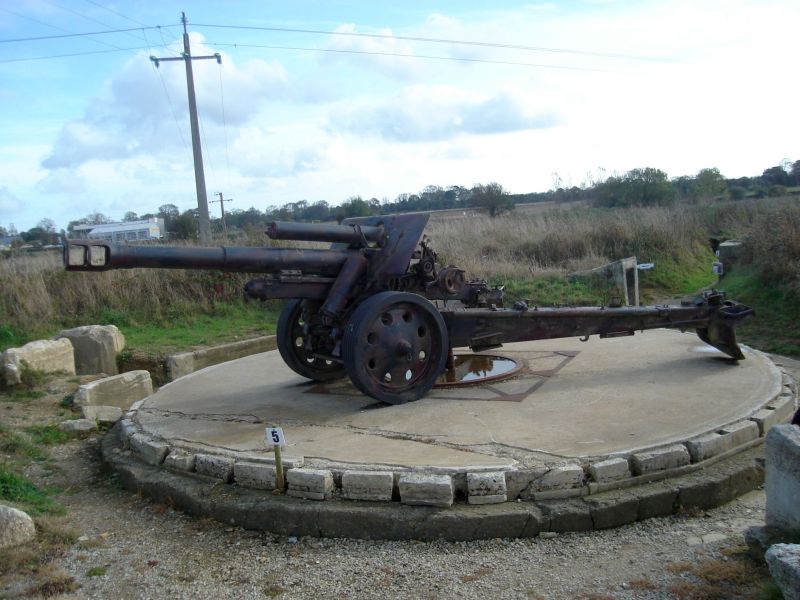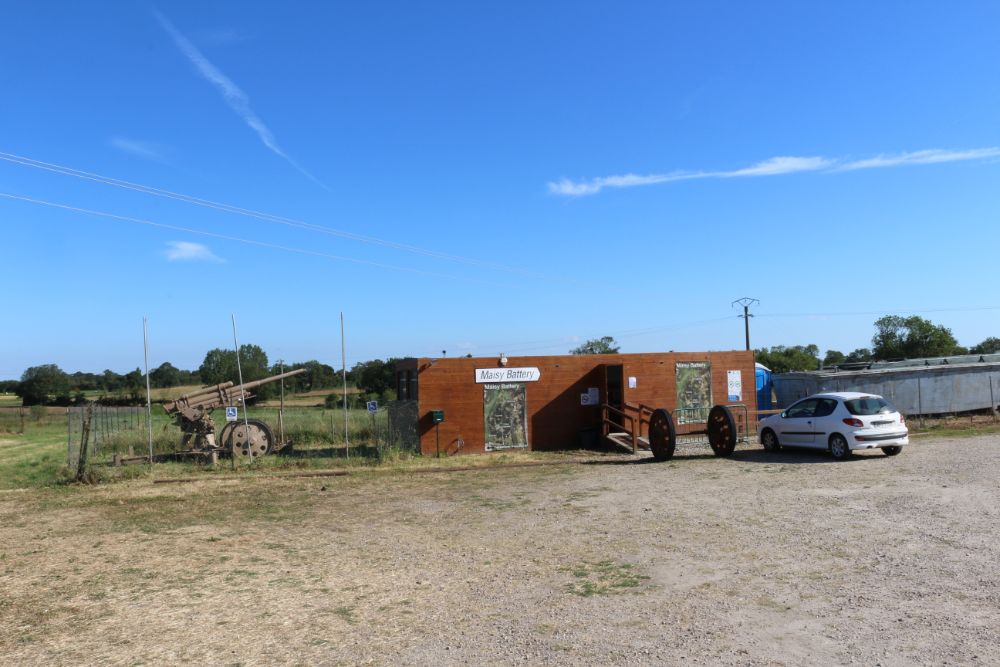| Title: | The Cover Up at Omaha Beach |
| Subtitle: | Maisy Battery and the US Rangers |
| Author: | Gary Sterne |
| Publisher: | Pen & Sword Military |
| Released: | 2013 |
| Pages: | 315 |
| Language: | English |
| ISBN: | 9781848844896 |
| Review: |
The Maisy Battery was a German artillery battery built by the Wehrmacht in 1943/1944, near the village Grandcamp-Maisy in north-west Normandy. The Germans called the battery Widerstandnest or resistance nest 83 or WN 83. The battery was located six kilometres south-west of Pointe Du Hoc and included six French 155mm howitzers, dating from the First World War, a captured allied 25 pounder, two 50mm antitank guns, bunkers, trenches, mortar setups, ammunition warehouses and machine gun nests. On D-Day, June 6, 1944, the Maisy Battery was manned by a four hundred strong German garrison. Besides, from June 3, 1944, WN83 was protected by an air defence unit consisting of twelve 88mm and 20mm Flugabwehrkanone, Flak. The Maisy Battery was built in secret by forced foreign labourers and its existence was virtually unknown even to locals. The battery, that could keep the allied beaches with the codes Utah Beach and Omaha Beach under fire, was not detected during Allied reconnaissance and indicated in any American or British ordnance map. The cannons of Maisy Battery kept Utah Beach and Omaha Beach under fire until June 9, 1944, and were rendered harmless on that day by the guns of Allied warships and a ground attack by the American Rangers. Strangely enough, the remains of the battery were, before the end of the war, covered up by the Americans with a meter-thick layer of earth. The battery WN83, which was now located below ground level, became over the years overgrown by bushes and, since it was not listed on any official map, fell into oblivion.Because the military information of the Allied assault on Normandy was kept secret by the British authorities for 60 years, Maisy Battery disappeared even more to the background. In 2004, the British amateur historian Gary Sterne, an avid collector of military relics from the Second World War, found an unofficial map of the Normandy arena near Omaha Beach in a US Army uniform that he had bought on a market for militaria in Stockport, England. On the map, which was not very interesting, a point was indicated with the words "area of high resistance". During a search in Normandy, near Grandcamp-Maisy, he hoped to find a suitable place to start a war museum, Sterne encountered the place that was shown on the map. He found concrete surfaces that turned out to be the roofs of bunkers. Sterne did not know exactly what he had discovered, but what he did know was that it was a large complex, for around the bunkers was a vacant, overgrown field of at least 15 hectares. In the months and years after, he began to buy the ground bit by bit and cleared the buildings and trenches from bushes and the soil in 2006. In April 2007 he opened the complex to the public. In the first chapter of his book "The Cover Up At Omaha Beach" Gary Sterne explains extensively how he rediscovered Maisy Battery and the way he had it excavated. He had found his place to open a Second World War museum. From the international press he received recognition for rediscovering the historically and very interesting, but through the years of mystery very unfamiliar site. In 2006 and 2007 the rediscovery and public opening of Maisy Battery was still prominent news, but then attention disappeared very quickly. In 2008, the site popped back into the news, because of the adding of a few German-made 150mm howitzers that closely resemble the original howitzers of the Maisy Battery. From 2009 on the complex was threatened for the second time in its history to disappear in a gray mist of obscurity. Today the exhibits of Maisy Battery are rusting away in the salty Norman air and there is still the ticket sale, which also serves as a souvenir shop, a temporary building from 2007. Gary Sterne has announced however that a visitors centre will be built when the work on the land is finished. "The Cover Up at Omaha Beach" indicates a cover-up that has to do with Omaha Beach. But what did actually happen on this Allied landing beach in Normandy that had to be hidden? Gary Stern explains in his book that there was indeed a cover-up, that has, according to him, everything to do with Maisy Battery. He argues that this cover-up has to do with the attack on the absent guns at Pointe du Hoc. On the German defence complex, on Pointe du Hoc, a 100 feet high rocky point between Omaha Beach and Utah Beach, six 155mm howitzers were supposed to have been placed which could be targeted at both beaches. Therefore, this enemy artillery had to be destroyed before the actual landings on D-Day would take place. For this attack, a number of elite troops of the American Rangers were selected, that actually occupied Pointe du Hoc, but found no howitzers. According to Gary Sterne, the allied commander, General of the Army, Dwight Eisenhower, had pointed Pointe du Hoc as "Target No.1" on D-Day. He considered it of paramount importance because general field marshal Erwin Rommel, the commander of the German defences in France, had himself, for reasons of propaganda, repeatedly filmed between the defences on this rocky outcrop in Normandy. As a precaution, the German desert fox had the guns removed. Hence the headland between Omaha Beach and Utah Beach became a political goal rather than a military objective. The Guns of Maisy Battery shelled the landing beaches for three days after D-Day and were given the wrong priority by Eisenhower in this way and who primarily designated the wrong objective. To cover this up, Maisy Battery had to go and was the conquest of Pointe du Hoc by the Rangers widely reported and for years commemorated, despite the fact there were no guns found on the cliff. In reality, the Germans had removed the 155mm howitzers of Pointe du Hoc months before D-Day, to build, in the open blanks, casemates prior to 105mm naval artillery. Four of these buildings were completed when the Rangers took Pointe du Hoc, two were still under construction, but in none of these structures artillery was located. The six howitzers were hidden in an apple orchard just south of the cliff. Apparently they were so well camouflaged that all Allied reconnaissance had missed them. Also the building of bunkers at Pointe du Hoc, and the fact that in a bunker under construction no gun can be located, escaped the allies apparently. The howitzers of Pointe du Hoc in the apple orchard, were just before the Germans wanted to focus them on Utah Beach, eliminated by different Ranger patrols on June 6 and 7. However, in "The Cover Up at Omaha Beach", Gary Sterne only pays attention, in the first and last of the eleven chapters, to the alleged cover-up. The remaining nine chapters of the book are summarized by the subtitle "Maisy battery and the U.S. Rangers". Gary Stern has chosen not to write these nine chapters himself, but to press ahead on the basis of testimonies of surviving Rangers that he had interviewed between 2009 and 2013. As a result, the book has become a more vivid eyewitness account of the events in and around Omaha Beach. Pointe du Hoc and Maisy Battery from the perspective of the Rangers themselves. Actually, this is a much more interesting fact than any cover-up. The Rangers describe the fights, the dangers and the many casualties that fell on Omaha Beach without any form of restraint. As a result, the testimonials become, although somewhat coloured, authentic, raw and real. Moreover, the Rangers do not avoid to question the wrong decisions of the Allied command. With "The Cover Up at Omaha Beach" Gary Sterne maybe missing the mark regarding a possible cover-up about the attacks on Pointe du Hoc and Maisy Battery. By contrast, till now, he is the only one that gives a rational explanation of the fact that the allied give so much attention to the attack on an enemy defence stronghold without guns. The history that hitherto have been written about D-Day in general, and the attack by Rangers at Pointe du Hoc in particular remains inconclusive on this tactical blunder. Gary Stern tries to, and that fact, together with the reports of the Rangers, makes reading "The Cover Up at Omaha Beach" more than worth it. |
| Rating: | |
Information
- Translated by:
- Han Smits
- Article by:
- Peter Kimenai
- Published on:
- 23-03-2014
- Last edit on:
- 25-10-2016
- Feedback?
- Send it!






